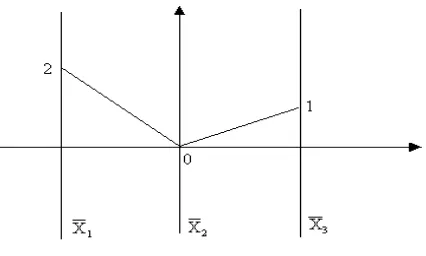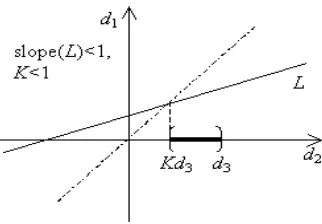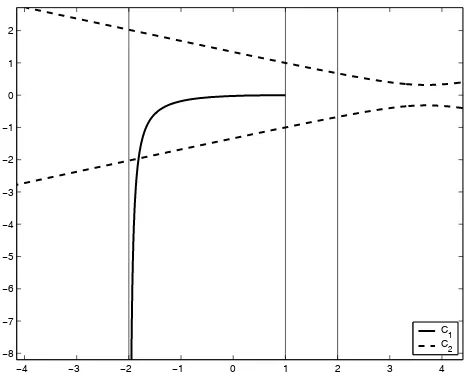SURFACES OF REVOLUTION IN
a-PARALLEL
COORDINATES
G. Paolini, M.R. Caldarelli, L.R. Castro∗
Dto. de Matem´atica, Univ. Nac. del Sur, 8000 - Bah´ıa Blanca, Argentina
gpaolini@ uns.edu.ar†, caldare@ criba.edu.ar, lcastro@ uns.edu.ar
Abstract
In this paper we present a method for visualizing surfaces of revolution in
R3 using an extension of the parallel coordinate system: thea-parallel coor-dinate system. The representation of 0-flats and 1-flats in this new system
is also given. In order to find the representation of surfaces of revolution in this new coordinate system, we define the extension of Eickemeyer’s flats to a wider class of sets, named flatsa.
Keywords: Parallel coordinates, visualization of surfaces.
1
Introduction
It is well known that parallel coordinates provide a methodology for unambiguous
visual-ization of multidimensional functions and, in turn, multivariate relations. In the Parallel Coordinate system, relations among theN real variables are mapped uniquely into subsets
of 2D-space, thus enabling the visualization of the corresponding N-dimensional hyper-surfaces. Using this system of coordinates, only certain kind of hypersurfaces can be
represented by their planar images.
There are many areas the Parallel Coordinates System can be applied - in economy, for
instance, hypersurfaces are used to model the economy of a country. Applications range from process control to conflict resolution for air traffic control, medicine, data mining on
Hung and Inselberg ([4]) gave several results for developable and partial results for
the representation in Parallel Coordinates of ruled surfaces using the Eickemeyer flats and the intersection of the surface with an adequate plane. In this paper, we extend this
representation to 3-dimensional surfaces of revolution. The method of parallel coordinates defined by Inselberg and Dimsdale ([2]) fails when representing surfaces of revolution, as
proved in this article. Therefore, it is not possible to use the Eickemeyer flats as defined in ([5]). Another class of flats that includes the other, is needed. In order to do this, we define a new parallel coordinate system and a class of flats which we nameda-parallel coordinates
and flatsa, respectively. Our approach uses a variation that allows the representation of
developable, ruled and revolution surfaces, according to the value of the parametera.
The paper is organized as follows: In Section 2 we summarize previous relevant results about parallel coordinates, we give some useful definitions and define the notation that
will be used throughout the paper. In Section 3 we define thea-parallel coordinate system and give the representation of p-flats (p= 0,1) in this system. In Section 4 we define the
p-flatsaand describe the method used to visualize surfaces of revolution in R3 in a system
of a-parallel coordinates. In Section 5 we give an example of application. We end this
paper in Section 6 by drawing the conclusions and outlining the future work.
2
Previous definitions and notation
The Euclidean N-space is referred to as RN. A p-flat in
RN is a linear subspace of RN
spanned by p+ 1 linearly independent points. Thus, a 0-flat is a point, a 1-flat is a line,
a (N −1)-flat in RN is a hyperplane. The terms point, and line are exclusively used for the objects that represent those subspaces, and that live in the parallel coordinate plane.
Vectors inRN are denoted by lower case English letters in boldface, and their components by the corresponding letter in italic with subscripts. The object in the parallel coordinate plane are usually labeled with the same corresponding symbol that labels the object in
RN they represent, overlined, and with adequate subscripts.
The projective plane on which we draw parallel axes and plot the representations is
denoted P2. The points coordinates on this plane are usually written using homogeneous coordinates.
labeledX1,X2, . . . , XN are placed perpendicular to theX−axis. They are the axes of the
parallel coordinates systemforRN all having the same positive orientation as theY−axis. The vector d ∈ RN denotes the vector whose components are the (signed) distances between the Y-axis and the parallel axes on the projective plane. Another vector of much significance is (1,1, . . . ,1)T. We shall call the 2-dimensional vector subspace spanned by
this vector and d, the Eickemeyer’s 2-flat and denote it byπE.
3
Representation of
0
-flats and
1
-flats in a system of
a
−
parallel
coordinates
Given a 0-flat π = (ξ1, ξ2, ..., ξN)T∈RN, we plot the points
d1,ξa1
, (di, ξi), i= 2, ..., N,
and call them πa1, πa2, . . . πaN. Then π is associated to the polygonal line joining πai and
[image:3.612.195.408.340.468.2]πai+1 , i= 1,2, . . . , N−1. Figure 1 shows the representation of the 0-flat π = (4,0,1) in the system ofa-parallel coordinates for a= 2.
Figure 1: Representation of the point (4,0,1) in 2-parallel coordinates.
The set of indexed points {πa1, πa2, ..., πaN} uniquely identify π and hence it will be referred to as the (a-parallel coordinate) representation of the (0-flat) π.
Remark 3.1 Let the parametric equation of the 1-flatπ ber(λ) =p+λh, where p,h∈R3
are constant vectors. Denote the points:
πai,j = (hidj−hjdi, pjhi−pihj, hi−hj)
for all 1< i=j≤N.
The points πa
i,j (1≤i < j ≤N) uniquely identify the 1-flat π, but we do not need all
these points to determine the 1-flat. In fact, ifN = 3 this representation is stated in the
following definition.
Definition 3.1 Let π be a 1-flat in R3 and πai,j the point in the a−parallel coordinate projective plane like in Remark 3.1. The a-parallel coordinate representation of the 1-flat
π is given by any of the points πa1,2, πa2,3or πa1,3, πa2,3.
From Definition 3.1, follows that a 1-flat is represented by two points in thea-parallel coordinate system.
4
Representation of surfaces of revolution
Without loss of generality, we consider the surfaces of revolution generated by the rotation of a curve C in R3 around a line L of equation P(t) = tn, t∈ A ⊆R, n = (n1, n2, n3),
ni ∈R,i= 1,2,3. The curveC is even respect toLand is contained in a plane containing
L.
In order to represent the surface in this system, we need two curvesC1 and C2. The first one is the image of the curveCand the second one the image of the curveC, obtained
as the intersection of the surface with appropriate planes. In parallel these planes are the Eickemeyer planes πE1 and πE2, respectively. The plane π1E is generated by the vectors u
andd and the planeπE
2 is generated byuandd, wheredanddare appropriately chosen.
Lemma 4.1 Let n = (n1, n2, n3) , n=0. If n1 = n2 = n3 every Eickemeyer plane contains n and some vector d= (d1, d2, d3), d1 < d2 < d3.
Proof. The planes of the form (d3−d2)x+ (d1−d3)y+ (d2−d1)z = 0 contains the vector nand any vector d= (d1, d2, d3),then we can choose it so thatd1 < d2< d3. QED
Without loss of generality, in what follows we suppose that the vectorn= (n1, n2, n3)
is not parallel to u. Let, for example, n2=n3 ,n2< n3.The following results are valid.
Theorem 4.1 There exists an Eickemeyer’s plane that contains the vectorn= (n1, n2, n3) and a vector d= (d1, d2, d3) , d1 < d2< d3 if and only if n1 < n2.
Proof. If n1< n2 < n3, it´s enough to choosed=n.
Letπ be the Eickemeyer’s plane that contains the vector d. Then:
d1(n2−n3) +d2(n3−n1) +d3(n1−n2) = 0.
Considering a fixed but arbitraryd3 ≥0, it follows that:
d1=
n3−n1
n3−n2 d2+
n1−n2
n3−n2 d3.
Then we have found a linear relationship betweend1 and d2. In order to ensure that
exists a vector d satisfying the required conditions, it must be:
n3−n1 n3−n2
>1;
and then n1 < n2. QED
From this theorem follows only those surface of revolution withn1 < n2 < n3 could
be represented using Eickemeyer’s planes. This motivates the following definition.
Definition 4.1 The 2-flata πa is the 2-dimensional vector subspace spanned by d and
va= (a,1,1), a∈R.
In what follows, we supposea >0.
Remark 4.1 The 2-flats1 are the Eickemeyer’s 2-flats.
Remark 4.2 If a1-flatalies onπathen the pointsπa1,2,πa2,3 (repectivelyπa1,3,πa2,3) defined in Remark 3.1 are coincident. Therefore, the representation of the 1-flata is a single point
in the a-parallel coordinate system.
Theorem 4.2 If n2 < n3 then exists a2-flata, a <1, that contains n.
- If 0< n3, results that
n3(1−a) +n1−n2<0,
and then follows
K = an2−n1
n3(1−a) +n1−n2
>1.
Then it suffices to choose d2 < Kd3. So taking into account that
d1=
an3−n1
n3−n2
d2+
n1−an2
n3−n2
d3, (1)
it follows
d2−d1 =d2
1−an3−n1
n3−n2
−n1−an2
n3−n2 d3
= n3−n2−an3+n1
n3−n2 d2−
n1−an2
n3−n2 d3
= n3(1−a)+n1−n2
n3−n2 d2−
n1−an2
n3−n2 d3.
(2)
From the last member of Equations (2) we have the following inequality
d2−d1 >n3(1−a)+n1−n2
n3−n2 −
n1−an2
n3−n2
d3
> (n3−n2)(1−a)
n3−n2 d3
= (1−a)d3 >0,
and then it is possible to conclude thatd1 < d2 .
- Ifn3 <0 then we have
−K=− an2−n1
n3(1−a) +n1−n2
>1
So, for anyd2< d3 it is enough to choose
d1= an3−n1
n3−n2
d2+n1−an2
n3−n2
d3,
and then follows thatd1 < d2.
- Ifn3 = 0, we have
d1 =
n1
n2
d2+
an2−n1
−n2
d3.
Asn1 > n2 , with n2<0 results that
n1
n2
<1.
Then
K= an2−n1
n1−n2
<1,
The geometric interpretation of the proof of Theorem 4.2 is as follows.
Consider in the plane two perpendicular axes, and call themd1andd2, andd3 any real number. We can think d1 = an3−n1
n3−n2 d2 +
n1−an2
n3−n2 d3 as a line L in this system coordinate.
The intersection between L and the lined1 =d2 is the point of coordinates: (Kd3, Kd3), where K= an2−n1
n3(1−a)+n1−n2.
Case 1. If the slope of L is less than one it must be K < 1, in order to exist d2 ∈ (Kd3, d3) that satisfies the given condition (see Figure 2).
Case 2. If the slope of L is greater than 1, it must beK >1. In this case anyd2 < d3
satisfies the given requeriment, as can be seen from Figure 3.
Case 3. Ifa <1 the cases slope ofLgreater than one andK <1 or slope of Lless than one and K >1 are not possible as is shown in Figures 4 and 5.
Ifa >1 the cases mentioned in the last paragraph are possible. Then, choosingd2 < Kd3
for Case 1, the vector d is determined. This shows that Theorem 4.2 gives a necessary but not a sufficient condition, as follows from Example 4.2.
[image:7.612.222.383.458.570.2]Example 4.2 If a = 2, n = (2,1,3), d = (−2,−1,1) and v2 = (2,1,1) then n is con-tained in the 2-flat2 generated by v2 andd.
Figure 2: Case 1.
Figure 3: Case 2.
[image:8.612.198.397.51.617.2]Figure 4: Case 3.
Figure 5: Case 3.
Proof: Let a >2. Then
and it results
an3−n1
n3−n2 >1.
As (a−1)n2 <(a−1)n3, then
an2−n1
n3(a−1) +n2−n1 <1.
So it suffices to choosed2∈(Kd3, d3). QED
Example 4.3 Letn= (−1,3,5). Then we can choosea= 3 ,d= (−d3−2,−d3−1, d3), so that n is contained in the 2−flat3 generated by v3 y d.
Let πa be the plane generated by d and va and πa be the plane generated byd and
va. The curves C and C are found as the intersection of the surface with the planes πa
and πa, respectively.
According to Section 3 and Remark 4.2 we represent, in the a-parallel coordinate
system, each tangent line to the curveC and C, respectively . These sets, namedC1 and
C2 represent the curves C andC, respectively. Now we can summarize the procedure as follows.
Step 1. Choosed3 >0 and fix any a >1.
Step 2. Choosed2 according to Theorem 4.2.
Step 3. Setd1 given by (1).
Step 4. Letd= (d′
1, d2, d3) such that d′1 > d3.
Step 5. Draw, in the a-parallel coordinate system, the curves C and C.
5
Example of Application
Let us consider the surface of revolution generated by the rotation of the the curve C in
R3 given by:
x =−5t,
y = 5t2, t >0, z = 8t2+t,
around the line of equationP(λ) = (−1,3,5))λ, λ≥0. The curveCis given by equation:
x = cosα,
y = sinα, α∈[0,2π), z = cosα−2 sinα+ 26.
(4)
Choosing a= 3 we have, according to Theorem 4.2, d = −d3,21d3, d3, withd3 >0 and d =2d3,12d3, d3. The curve C belongs to πa, the plane generated by d and va =
(3,1,1) and the curveC belongs toπa, the plane generated by ˜d and va.
The points that represent the curve C in the 3-parallel coordinate system are given
by:
π312=
d3(1−12t) 2 (6t+ 1) ,
−5t2
(6t+ 1)
, t >0. (5)
For the curveC these points are given by the following expression:
π312=
d36 cosα+12sinα
3 cosα+ sinα ,
1 3 cosα+ sinα
, α∈[0,2π). (6)
In Figure 6 are shown bothC1 and C2, the curves obtained when drawing the points given by equations (5) and (6), withd3= 2.
−4 −3 −2 −1 0 1 2 3 4
[image:10.612.185.418.367.559.2]−8 −7 −6 −5 −4 −3 −2 −1 0 1 2 C 1 C 2
Figure 6: Representation of a surface of revolution in the 3-parallel coordinate system.
6
Conclusions
that generalizes the work of Hung and Inselberg for representing surfaces of revolution.
To do this, it was necessary to define our so called a-parallel coordinate system. This new system allows for the representation of developable, ruled and revolution surfaces in 3D.
Although the methodology is restricted to 3D surfaces, we are are working on its extension to N-dimensional hypersurfaces of revolution. In this case, all the applications known so
far for ruled and developable surfaces could be extended to a wider class of hypersurfaces.
References
[1] Chatterjee, A. and A. InselbergVisualizing multi-dimensional polytopes and topologies
for tolerances. Research Report RC 20133 (89022), IBM Reserach Division, Yorktown Heights, New York, 1995.
[2] Inselberg, A. and B. Dimsdale. Multidimensional lines I: representation. SIAM
Jour-nal of Applied Mathematics, Volume 54, Number 2, pages 559-577, 1994.
[3] Inselberg A., J. Hassett and A. Chatterjee.Visualization of Multi-dimensional
Geom-etry and Application to Multi-variate Problems. SIGGRAPH’95 Course Notes, Course No. 27, 1995.
[4] Inselberg, A and C.K. Hung. A new representation of hypersurfaces in terms of
tan-gent hyperplanes. Proc. of SIAM Conference on Geometric Design, 11, 1991.



